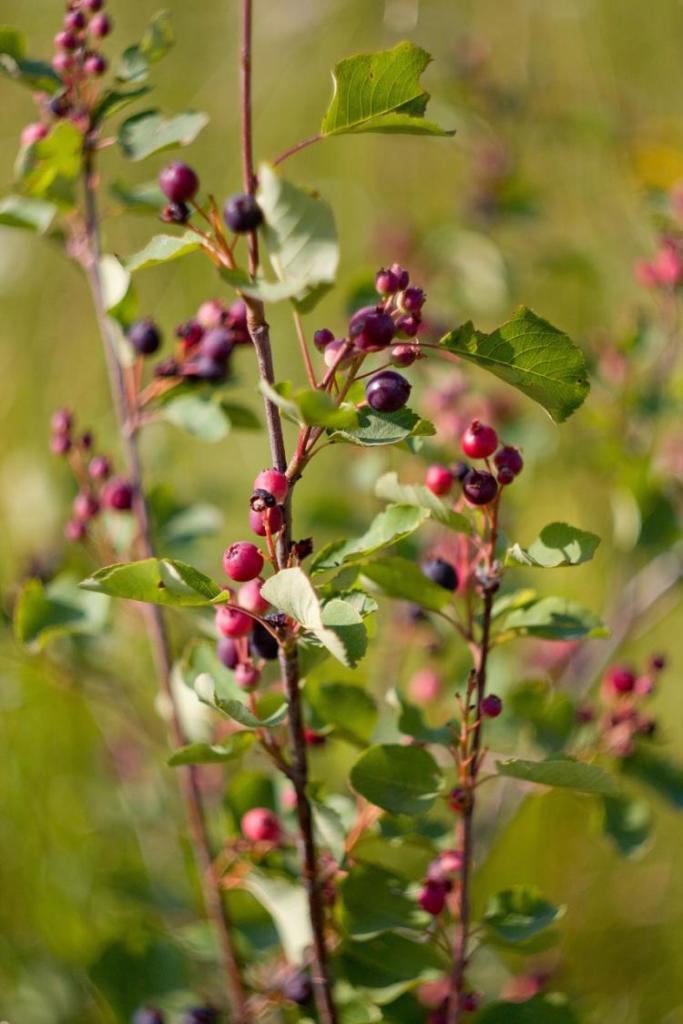By Tony Chalcraft
Homegrown, juicy, sweet fresh berries are one of the highlights of the summer. Many gardeners grow strawberries, raspberries and blueberries. Some may cultivate blackcurrants, gooseberries and redcurrants, berries that are now a bit out of fashion. Fewer may grow tayberries and loganberries, and a handful boysenberries, jostaberries, tummelberries, wineberries and youngberries, to namecheck some other unusual types. I’ve tried most of these over the years, but my current ‘unusual’ summer berry is the saskatoon.
I was prevailed upon to try this by a Canadian friend. The word saskatoon is better known from the city of the same name in Saskatchewan, but Wikipedia tells me the place is named after the saskatoon bush, a berry-bearing shrubby plant native to the Canadian Prairies. Also sometimes called the juneberry, because it crops relatively early, or the serviceberry, its scientific name is Amelanchier alnifolia. Seasoned gardeners will know the Amelanchier genus mainly as a range of ornamental small trees and shrubs cultivated for their showy white spring blossom and vivid autumn colour. The saskatoon shares these features but has larger berries than its decorative relatives. On a well-grown bush these can be about the size of a blueberry and have a similar blueish-purple hue. The taste is often said to be between that of cherries and blueberries with a hint of almonds. This seems a touch imaginative, but the saskatoon is pleasant and palatable, if slightly acidic. One downside is that the berries can be quite pippy. The pips are sometimes said to taste of marzipan, but this may only be detectable by those with especially individual tastebuds.
As a crop, the saskatoon is relatively trouble free. One downside, as with almost any berry, is the need to protect form blackbirds which seem to relish the fruit. Another issue is the time it takes to harvest the relatively small berries, especially as not all ripen at the same time so that individual, rather than cluster, picking is necessary. On the plus side, as you might expect from a plant originating from an area of freezing winters and dryish summers, the saskatoon seems oblivious to cold and drought and doesn’t seem to be susceptible to any pests or diseases other than pilfering birds. Unlike blueberries saskatoons are self-fertile and do not need a pollination partner. Some attention to pruning is required as bushes can grow well over two metres. This is necessary not only to reduce height but to improve cropping. Experience suggests that berries are borne better on younger growth so I remove some older wood each winter. Something else to watch out for are suckers (new vegetive growth arising from the root system). These need to be removed to maintain a tidily shaped bush easily accessible for picking. Leave and you risk a tangled thicket.
Perhaps the best attribute of the saskatoon is its nutritional value. Often feted as a ‘superfood’ it is big on antioxidants and fibre and particularly high in calcium. Not only is it good for you but it’s versatile. Palatable raw, many would consider it even better cooked or processed. Excellent in pies it can also be pureed and used to flavour ice cream and drinks. Unfortunately, because of the small berry size, I suspect the saskatoon will remain an unusual summer berry. But if you’re a pioneering gardener looking for something less fussy than a blueberry it could be worth a try.











Add a comment